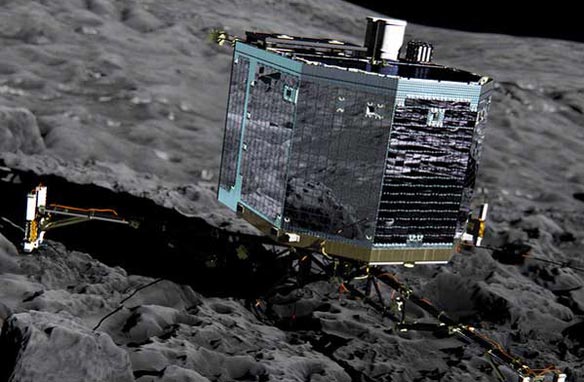

Already on 8 November, the ground crew sent the computer sequence that controlled the landing to Philae via the orbiter. On Monday, the lander was switched on and heated. On the morning of 12 November, the mother spacecraft Rosetta hovered just over 22 kilometres above the powdery surface of the comet 67P / Churyumov-Gerasimenko.
Between 7.35 and 8.35 CET, the final 'go' was given by the ground control centre. Experts of the European Space Agency checked whether Rosetta's orbit was correct. Even though there were problems with the lander cold gas system, which was supposed to push Philae gently onto the comet surface after landing, the decision was made to separate as scheduled. Three preloaded springs manoeuvred Philae into space with a gentle nudge at 9.35 CET. The refrigerator-sized box drifted away from the mother ship.
At 10.03 CET the control centre ESOC in Darmstadt confirmed the successful separation. Approximately two hours after the separation, data transfer began. The lander sent signals to the orbiter, from which they travelled to earth at the speed of light. Because the comet is flying through space at a distance of 500 million kilometres from our planet, the signals took 28 minutes and 20 second to reach us. They reached ESOC at 12.07 CET.
With this delay, the researchers and technicians already gathered information on the status of Philae during the descent Around 12.25 CET it was confirmed that the three landing legs and a sensor had been deployed. Moreover, first pictures of the on-board camera CIVA should soon arrive and measurements from instruments such as the radio radar CONSERT be transferred.
During the descent, Philae itself could not be controlled from Earth. Rather, the 100 kg mass spacecraft drifted in free fall towards the comet's nucleus at the speed of 18 kilometres per second. The landing area – recently christened Agilkia after a naming contest by ESA – was imprecise; the landing ellipse had an area of more than half a square kilometre. Due to the precise separation manoeuvre, Philae was exactly on course; the diameter of the landing ellipse had been reduced to 400 metres.
Roughly two hours after separation, Rosetta's onboard OSIRIS camera system was looking at the departing lander. “Philae is on a good way,” Hermann Böhnhardt from the MPI for Solar System Research, lead scientist of the landing mission, commented. As evidenced by the most recent image, the lander had also successfully unfolded its legs. “To be able to watch this historic landing through the eyes of our camera is a feeling that cannot be described in words,” says Max Planck Researcher Holger Sierks, leader of the OSIRIS team. “Since Rosetta's launch more than ten years ago, we have not seen any images of the lander. Now it is floating freely in space on its way to the comet's surface”.
16.34 h CET: Touchdown, Philae has landed! When the probe touched down at a rate of three and a half miles per hour, two explosive harpoons were fired into the surface. In addition, screw-like tips under the footpads of the three legs of the lander drilled into the comet's crust. A shock absorbing mechanism in the central cavity of the landing gear absorbed the energy and ensured that Philae did not bounce into space.
At 17.03 CET, signals were received by control. It was clear soon after this: Landing was successful! The touch-down signal is triggered at the moment in which the central element of the landing gear was pushed upwards by the landing and the contact pressure. Also data about the release of the harpoons reached earth quite rapidly.
Next, the first pictures of the panoramic camera on the monitors appear. Is the horizon of the comet visible? The greatest danger for Philae is offered by the terrain itself. While the landscape appears to be very flat, chunks on the surface or a slope could have considerably affected the landing.
If one of the legs of the probe had landed on a rock or a slope, and if the slope had been inclined by more than 30 degrees, Philae could have rolled off – which would probably have meant the end of the mission.
Now the first science sequence will begin. First, experts analyse illumination in order to gain crucial evidence for the energy supply; because the batteries of the lander are charged via solar energy. Afterwards, all of the board instruments are put into operation.
The “hot phase”, in which Philae is to measure and collect data, should last at least 60 hours. Secretly, engineers and scientists hope that the lander will survive significantly longer. Actually it is supposed to work up to a distance of about 300 million kilometres from the sun.
This point will be reached at the end of March 2015. After that, things should come to an end. If it is not hit and hurled into space by a dust fountain, the lander will overheat or perish through energy deficiency caused by dirty sun panels. Until then, Philae could have revolutionized our picture of comets.
Contact
Dr. Birgit Krummheuer
Press and Public Relations
Max Planck Institute for Solar System Research, Göttingen
Phone: +49 551 384979-462
Email: Krummheuer@mps.mpg.de












